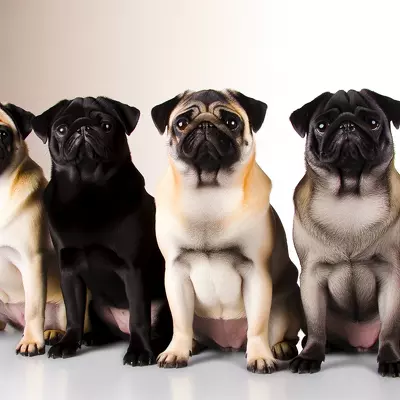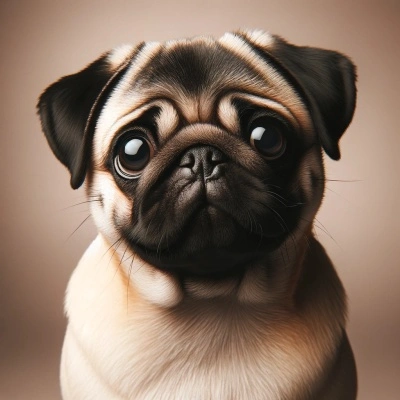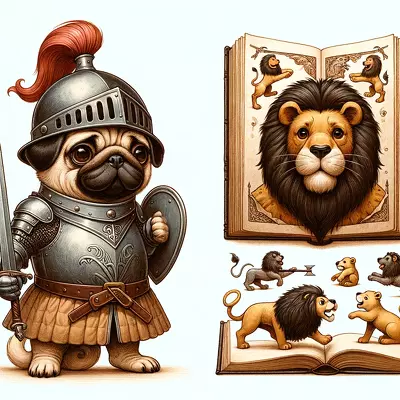Exploring the Different Colors of Pugs: A Guide to Their Unique Beauty

Pugs, with their wrinkled brows and big, soulful eyes, have charmed pet lovers worldwide. These compact companions come in an array of shades, each adding to their unique appeal. From the deep hues of black and fawn to the rare silver or apricot, the variety in color among pugs offers a fascinating glimpse into the breed’s diversity. This variety not only adds to their aesthetic appeal but also showcases the rich genetic tapestry that defines them.
I. Introduction
Pugs have long been cherished for their distinct appearance and endearing personalities. Known for their expressive faces and compact, muscular bodies, they also come in a variety of colors. This range of hues not only adds to their charm but also speaks to their rich heritage and genetic diversity. Exploring the different colors of pugs offers insights into the breed’s history, health, and beauty.
II. Understanding Pug Colors
A. Recognized Colors by Major Kennel Clubs
Major kennel clubs around the world acknowledge a specific palette of colors for pugs. These typically include fawn, black, and sometimes silver. Recognized colors play a significant role in dog shows and breeding standards, emphasizing the breed’s traditional and desirable traits.
B. The Genetic Basis of Pug Colors
The colors of pug coats are determined by their genetic makeup. A combination of genes dictates not only the color but also the pattern and intensity of the coat. Understanding these genetics can help breeders predict the color of puppies and maintain the health and standard of the breed.
C. Common Myths About Pug Colors
Several myths surround pug colors, such as certain colors being healthier or having better temperaments. These misconceptions often need more scientific backing and can lead to misinformation about the breed. It’s important to debunk these myths and focus on facts when considering pug colors.
III. The Spectrum of Pug Colors
A. Fawn: The Classic Shade
- Variations Within Fawn
Fawn pugs can range from a light, creamy color to a deeper, richer gold. This variation adds to each dog’s individuality, with some showcasing distinct black masks that add contrast and character. - Coat Care for Fawn Pugs
Fawn pugs require regular grooming to maintain their coat’s appearance and health. This includes brushing to remove loose hair and bathing to keep the skin clean and healthy.
B. Black: A Sleek Option
- Characteristics of Black Pugs
Black pugs possess a uniform, glossy coat that can appear even more striking against their expressive eyes. Unlike their fawn counterparts, black pugs have a solid coloration without the traditional mask. - Health Considerations for Black Pugs
Black pugs share health considerations similar to other colors but may require extra care to keep their coat shiny and skin healthy. Regular grooming and attention to any signs of skin issues are important.
C. Rare and Unique Colors
- Silver and Apricot Pugs
Silver and apricot pugs are less common but highly prized for their unique shades. Silver pugs have a light, almost metallic coat, while apricot pugs display a soft, warm hue. - Brindle and White Pugs
Brindle and white pugs are even rarer, with distinctive patterns and colorations. Brindle pugs have a mix of colors, creating a striped effect, whereas white pugs are known for their pure, snowy coats. - The Controversy Around Rare Colors
Rare colors can be subject to controversy, with concerns over health and breeding ethics. It’s crucial to prioritize the well-being of the dogs over the pursuit of specific colors.
IV. Choosing a Pug: Does Color Matter?
A. Personality and Temperament Across Colors
Research and anecdotal evidence suggest that a pug’s color has little impact on its personality or temperament. Pugs are generally known for their friendly, pleasant nature, regardless of coat color.
B. Health Implications Linked to Coat Colors
Some studies indicate a link between coat color and health issues in dogs, but the evidence is not conclusive for pugs. Prospective owners should consider overall health and genetics rather than color alone.
C. The Impact of Color on Pug Adoption
Color can influence adoption choices, with some colors being more sought after. However, all pugs deserve loving homes, and color should not be the sole factor in adoption decisions.
V. Caring for Your Colored Pug
A. Nutrition and Diet
A balanced diet is crucial for maintaining the health and coat quality of pugs. Specific nutritional needs may vary based on age, activity level, and health conditions.
B. Grooming and Skin Care
Regular grooming is essential for all pug colors to prevent skin issues and keep their coat in good condition. This includes brushing, bathing, and monitoring for any signs of irritation.
C. Health Screenings and Preventive Measures
Routine health screenings can help identify and manage potential health issues early. Preventive measures, such as vaccinations and parasite control, are also important for pugs’ well-being.
VI. FAQs
Q: Are certain pug colors rarer than others?
A: Yes, while fawn and black are common, rarer colors are silver, apricot, brindle, and white.
Q: Does the color of a pug affect its health?
A: There’s no conclusive evidence that color directly impacts health, but breeding for specific colors should always prioritize health and genetics.
Q: Can pugs change color as they age?
A: Pugs can slightly change color with age, especially lighter-colored pugs, which may develop a more pronounced hue.
Q: Is it harder to care for certain colored pugs?
A: All pugs require similar care, though black pugs may need extra grooming to maintain their glossy coats.
Q: Do pug colors have different temperaments?
A: There’s no scientific basis for color influencing temperament; pugs are generally affectionate and friendly regardless of color.
Q: Are rare-colored pugs more expensive?
A: Rare colors can command higher prices due to their uniqueness, but ethical breeding practices should always be the priority.
Q: How can I ensure my pug’s coat stays healthy?
A: Regular grooming, a balanced diet, and routine veterinary care are key to maintaining a healthy coat and overall well-being.
VII. Conclusion
A. The Beauty and Diversity of Pug Colors
The variety of pug colors adds to the breed’s appeal, showcasing their unique beauty and diversity. Each color, from the classic fawn to the rare silver, brings its charm and character to these lovable dogs.
B. The Significance of Responsible Breeding
Responsible breeding is crucial in maintaining the health and standard of pugs. Ethical breeders prioritize the well-being of the dogs over color trends, ensuring a healthy and happy life for these companions.
C. Embracing the Pug Regardless of Color
Ultimately, the color of a pug is just one aspect of their appeal. Their playful and affectionate nature makes them beloved family members, regardless of their coat’s hue.
VIII. Suggested Readings
Before diving into the world of pugs, it’s beneficial to arm yourself with knowledge from reliable sources. Here are some recommended readings for those interested in learning more about this charming breed.
- “The Complete Guide to Pugs” – This comprehensive book covers everything from care and training to the history of the breed, offering valuable insights for both prospective and current pug owners.
- “Pug Handbook” – A detailed resource that delves into the specific needs of pugs, including health, nutrition, and grooming tips tailored to their unique requirements.
- “Pugs for Dummies” – Part of the popular ‘For Dummies’ series, this book provides a friendly introduction to raising, training, and caring for pugs, making it an excellent choice for first-time pug owners.
- “The Pug Breed Lover’s Guide” – A deeper exploration of the breed, this book examines the history, personality, and care of pugs, with a special focus on understanding their behavioral traits.
After exploring these resources, you’ll be better equipped to appreciate the delightful world of pugs. Whether you’re a seasoned pug enthusiast or considering adding one to your family, these books offer valuable insights and guidance to enhance your journey with these affectionate companions.






